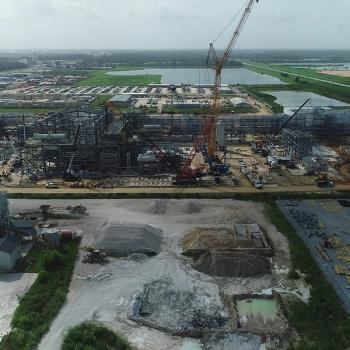
Alstom HRSG
The new HRSG developed by Alstom, Optimized for Cycling and Constructability (OCC), provides a cycling capability and has a design which requires reduced field construction labor. It features a horizontal gas path with suspended vertical tubes arranged in single rows. The HRSG is is a three-pressure reheat cycle that can be combined with an integral duct burner system and catalytic emissions controls.
(For project sites with high labor cost and deep water access, Alstom can provide a fully assembled HRSG)
The three-pressure reheat cycle improves the efficiency of the steam/water cycle resulting in higher power output. The duct burner provides additional electrical peaking capacity by firing additional fuel into the HRSG to produce more steam thereby increasing turbine electrical output. Catalytic emissions controls reduce nitrogen oxides, volatile organic compounds and carbon monoxide stack emissions. Selective Catalytic Reduction (SCR) technology is used to reduce nitrogen oxides to form elemental nitrogen and water. Oxidation catalysts are harnessed to oxidize carbon monoxide and hydrocarbons prior to exiting the stack.
Enhancing cycling performance
The OCC design uses single-row harps as the building block for the pressure parts with standardized tubing and header designs. The heat transfer tubing is coupled to thin-wall inlet and outlet headers which are 3 inch or 4 inch NPS for all harps. The top-supported design also allows for the use of smaller diameter tube and header designs for increased cycling performance. The straight tubing between the headers removes stresses typically seen in a conventional bent tube design. This configuration provides lower thermal stresses and thus start-up times are conducive.
The harp construction utilizes a stepped thickness change from the tubes to headers and finally to the manifolds. The ratio between header thickness and tube thickness is approximately 3 compared to 8 for conventional designs, which helps to minimize the temperature difference between tube wall and header wall during start-ups and thus causes smaller thermal stress. The advantage of the single-row design is that the tube-to-header connections are no longer vulnerable and the link-to-manifold connections are fewer and easier to inspect.
Stronger steel increases cycling flexibility
The use of higher alloy steels has increased the cycling capacity and reliability of the HRSG. The use of stronger grades of steel, such as grade 91, in the high temperature areas of the high-pressure superheater and reheater helps to minimize component wall thickness, which provides additional cycling flexibility. The use of duplex stainless steel in the feedwater preheater allows for corrosion resistance in cases of highly oxygenated feedwater supply. The rapid cooling of harps due to the purge cycle after a trip or short shutdown can generate condensation that can result in thermal gradients within tubes and headers that can lead to decreased life and failure.
In order to handle the transient conditions associated with purging, enhanced superheater and reheater drain arrangements are provided to prevent condensate flooding and thermal shock. The optimized design provides ample drain capability to remove condensate from the harps as it is generated during the purge cycle.
Alstom reports that this HRSG design has reduced the number of field welds by moving them to a shop fabrication scope. In all, the number of large bore welds on a typical job has dropped from 1060 welds to about 270. The number of modules has been reduced by packing more heat transfer surface in a given space thereby increasing the module size and weight, which reduces the number of crane lifts in the field. Maximum module size is dictated by both module access and transportation. Modules are limited in depth by the requirement to access the tubing within the HRSG, and limited in width by the mode of transportation, especially rail and truck deliveries.
For applications with short construction schedules or high labor cost, the OCC HRSG is available in a C-Frame configuration. The pressure part modules are combined with the structural steel, casing, insulation and liner into an integrated package. For project sites with high labor cost and deep water access, Alstom can provide a fully assembled HRSG. The only components that will need site assembly will be the stack, and installation of the SCR and CO catalyst modules after the turbine commissioning.
Newsletter
Power your knowledge with the latest in turbine technology, engineering advances, and energy solutions—subscribe to Turbomachinery International today.




